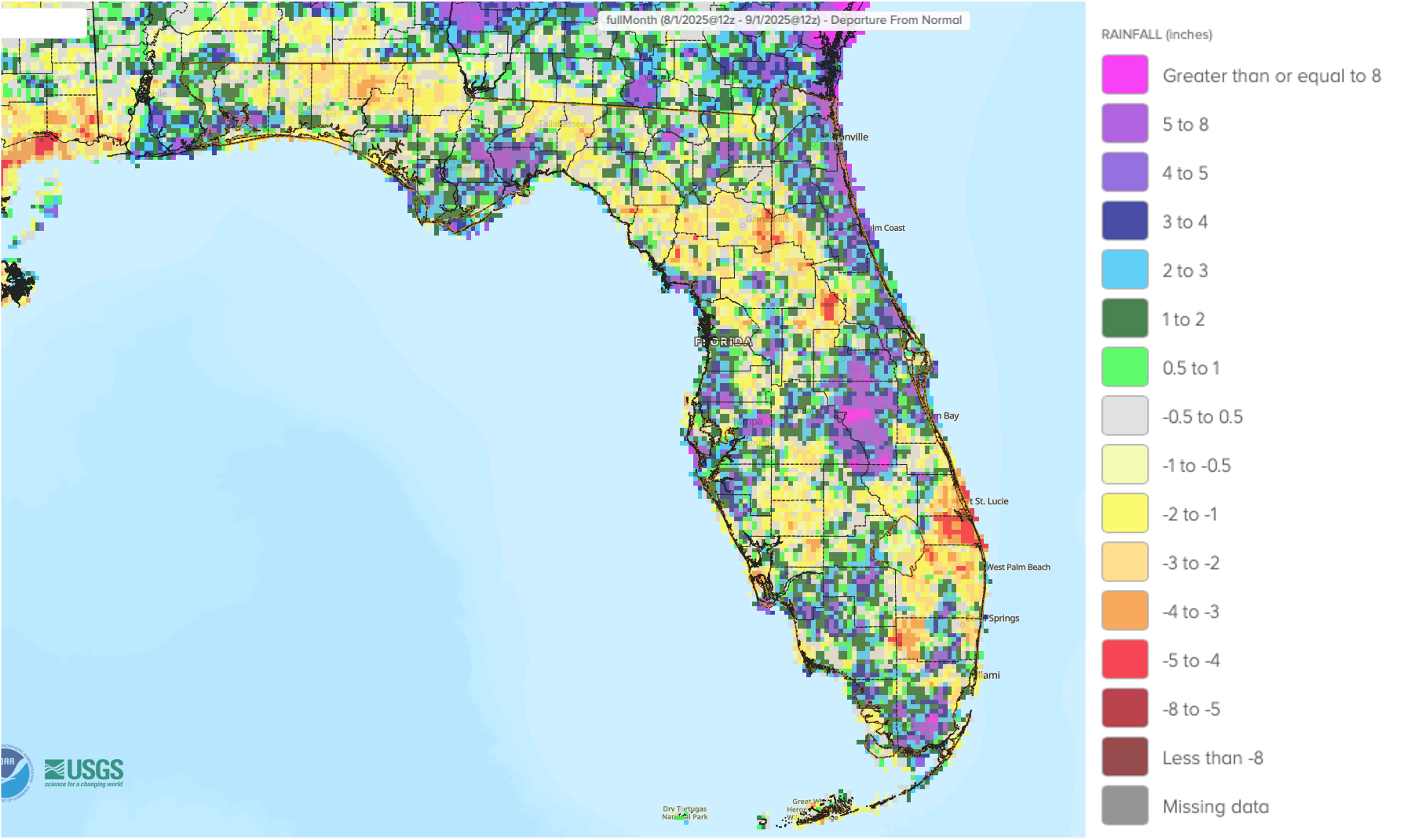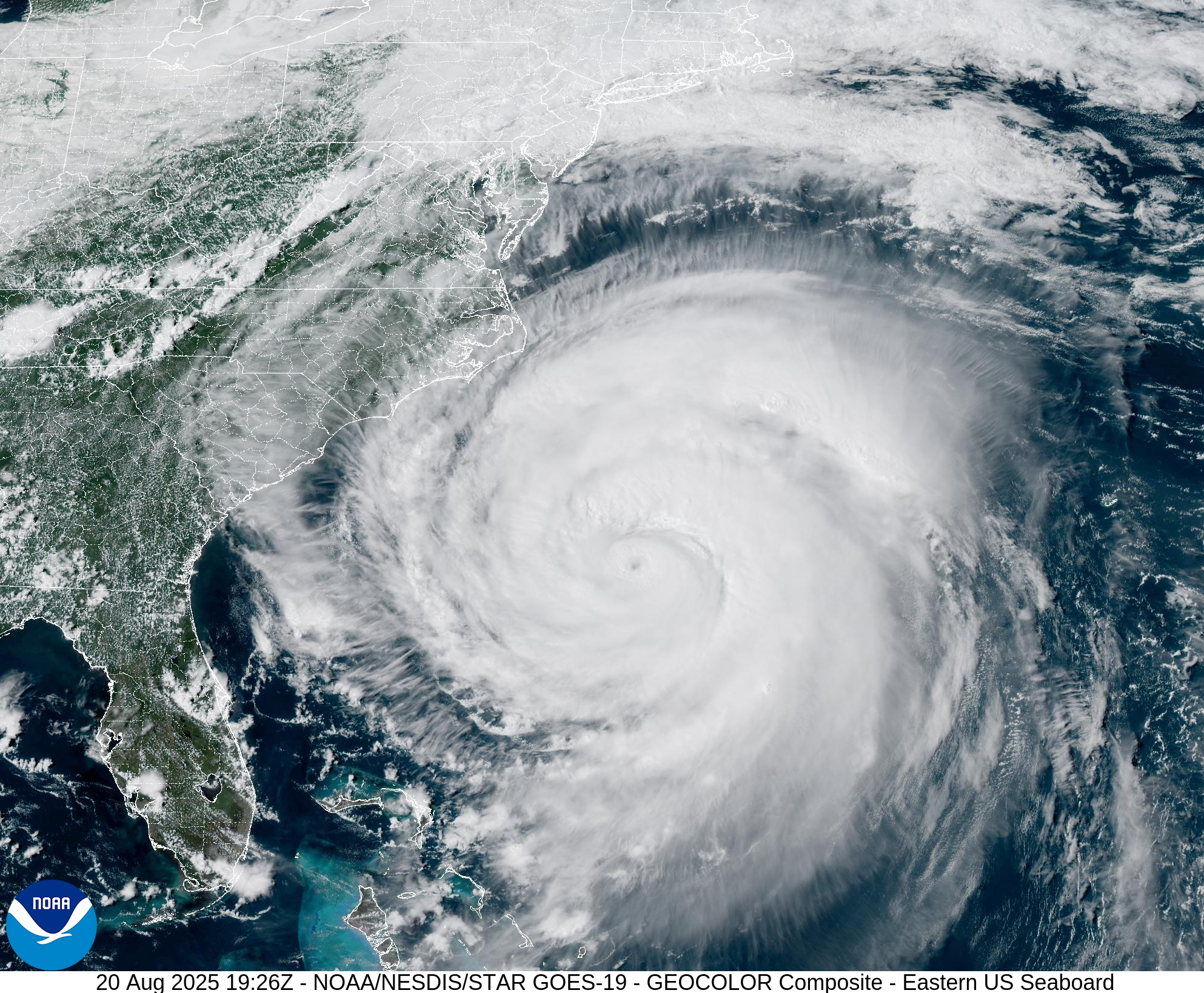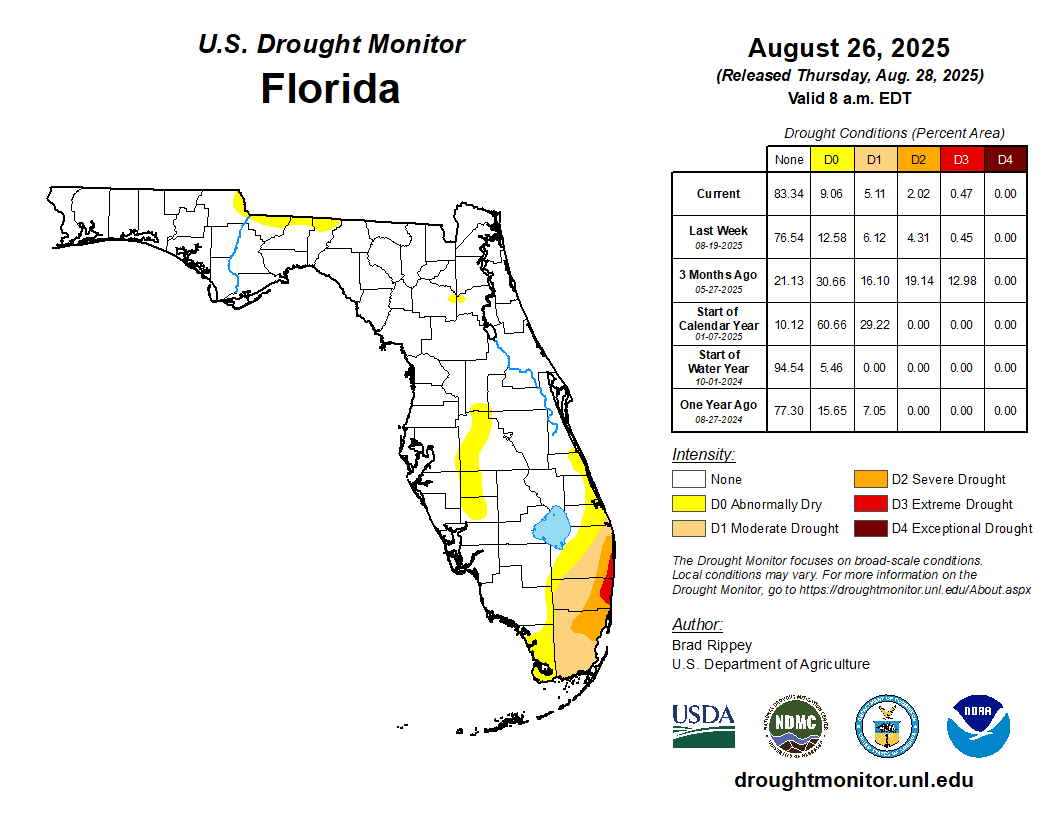Prepared by Florida Climate Center
The Florida State University
Tallahassee, FL
Summary:
- Monthly average temperatures in August were mixed, with below to near normal temperatures in the Panhandle and near to above normal temperatures in the Peninsula.
- Monthly precipitation totals in August were near to above normal in the Panhandle and western Florida, above normal in northeastern Florida, and below normal in central to southeastern areas.
- Drought conditions improved during August, but moderate (D1) to extreme drought (D3) persisted in southeastern Florida where large year-to-date rainfall deficits exist.
- A brief period of La Niña is favored to develop in the equatorial Pacific Ocean during fall and early winter 2025-26 (~58% chance during October-December), followed by a return to ENSO-neutral conditions.
Table 1. August average temperatures and departures from normal ( ̊F) for select cities.
| Station | Mean Temperature | Departure from Normal |
| Pensacola | 82.0 | -1.0 |
| Tallahassee | 81.8 | -0.6 |
| Jacksonville | 83.2 | +1.1 |
| Orlando | 83.8 | +1.2 |
| Tampa | 85.3 | +1.3 |
| Miami | 85.3 | +1.1 |
| Key West | 85.5 | 0.0 |
Table 2. August precipitation totals and departures from normal (inches) for selected cities.
| Station | Total Rainfall | Departure from Normal |
| Pensacola | 12.00 | +4.50 |
| Tallahassee | 7.18 | -0.42 |
| Jacksonville | 6.51 | -0.37 |
| Orlando | 7.31 | -0.38 |
| Tampa | 11.20 | +2.17 |
| Miami | 5.88 | -3.70 |
| Key West | 4.59 | -0.78 |
Figure 1. A graphical depiction of the monthly rainfall departure from normal (inches) for August (courtesy of NOAA, NWS).

La Niña Watch.
ENSO-neutral conditions are currently present in the tropical equatorial Pacific Ocean and are likely to persist through the late Northern Hemisphere summer and early fall (56% chance during August-October). During the past month, near-average sea surface temperatures (SSTs) continued across most of the equatorial Pacific Ocean. The latest weekly Niño SST index values ranged from -0.3 ̊C to 0.0 ̊C. Subsurface temperature anomalies became weakly negative in the eastern Pacific Ocean during the past month. A brief period of La Niña is favored to develop during the fall and early winter 2025-26 (with a roughly 58% chance during October-December) before returning to ENSO-neutral conditions.
Hazardous Weather Events in August.
According to the Local Storm Reports issued by the local National Weather Service offices serving Florida, there were 287 individual local reports of hazardous weather events recorded across the state during the month of August (see Table 3 for a breakdown by event type). The Palm Beach County wildfire in the early part of the month burned a total of 11,400 acres and was reported as 100% contained by August 4th. Later in the month, a wildfire burned in rural Broward County and impacted visibility and air quality in metro areas of southeastern Florida. Thunderstorms throughout the month led to flash flooding and strong wind gusts. Lightning led to two injuries and caused a structure fire in Marion County mid-month.
Table 3. Breakdown of storm reports submitted in Florida during the month of August (compiled from Iowa State University/Iowa Environmental Mesonet).
| Report Type | Number of Reports |
| Heavy Rain | 62 |
| Flash Flood | 9 |
| Flood | 17 |
| Hail | 5 |
| Marine Thunderstorm Wind | 41 |
| Non-Thunderstorm Wind Gust | 3 |
| Tornado/Waterspout/Funnel Cloud | 2 / 21 / 4 |
| Thunderstorm Wind Damage | 15 |
| Non-Thunderstorm Wind Damage | 0 |
| Thunderstorm Wind Gust | 96 |
| Lightning | 6 |
| Wildfire | 4 |
Daily Record Events in August.
Table 4. Summary of daily records broken or set in Florida in August (source: NCEI Daily Weather Records).
| Category | Number of Records |
| Highest daily max. temp. | 44 |
| Highest daily min. temp. | 40 |
| Lowest daily max. temp. | 11 |
| Lowest daily min. temp. | 6 |
| Highest daily precipitation | 23 |
| Total | 124 |
Weather/Climate Highlights of the Month: Hurricane Erin
Hurricane Erin became the first hurricane and first major hurricane of the 2025 Atlantic Hurricane Season. Tropical Storm Erin developed into a hurricane on August 15, just a few days behind climatology, and Erin quickly strengthened from a Category 1 to a Category 5 hurricane between the evening hours of Friday, August 15, and Saturday morning, August 16, as it moved through warm water in the Atlantic. As a category 5 hurricane, Erin passed just north of Puerto Rico and turned northward.
Erin experienced extreme rapid intensification as maximum sustained winds increased by 85 mph in under 24 hours, which far surpasses the threshold for rapid intensification (35 mph in 24 hours). The storm then experienced weakening to a Category 2 storm as it underwent an eyewall replacement cycle, but it maintained Category-2 strength for several days as it moved northward and grew in size.
While Erin did not make landfall in the U.S., the storm’s large size and wind field led to major impacts along the East Coast of the U.S. A mandatory evacuation was issued for parts of the North Carolina coast, as high wind gusts and large waves of 15-20 feet led to overwashing and major erosion along the coast. The storm was a timely reminder that hurricanes can still impact land without making a direct hit.

Drought-Related Impacts.
Drought improved across Peninsular Florida during August, but long-term drought continued to impact southeastern Florida as of late August, with extreme drought (D3) along the coastal portions of Palm Beach and Broward Counties. In mid-August, 0.17% of the state was in extreme drought (D3), about 5% was in severe drought (D2), 7% of the state was in moderate drought (D1), and 18% was abnormally dry (D0), according to the U.S. Drought Monitor. By the end of the month, approximately 0.5% of the state was in extreme drought (D3), 2% was in severe drought (D2), 5% was in moderate drought (D1), and 9% of the state was abnormally dry (D0) (Figure 2 below).
As of August 31, the Lake Okeechobee water level was 12.53 ft. above sea level (Feet-NGVD29), which is below average for this time of year. At the first of the month, the water level was 12.06 ft. above sea level.
Figure 2. A graphical depiction of the latest drought conditions in Florida according to the U.S. Drought Monitor (courtesy of the National Drought Mitigation Center, University of Nebraska-Lincoln).

Agriculture-Related Impacts.
In mid-August, topsoil moisture conditions were adequate in 82% of the state, short in 12%, and very short in 1% of the state, while 5% of the state had surplus topsoil moisture conditions. By the end of August, topsoil moisture conditions were adequate in 76% of the state, were short in 10% of the state, and very short in 0% of the state, while 14% of the state had surplus topsoil moisture conditions. For more information, consult the Crop Progress and Conditions report, which is published by the USDA’s National Agricultural Statistics Service.
Appendix 1
Additional August departures from normal data for select Florida locations (Source: NWS).
| Station | Average Temperature (˚F) | Departure from Normal (˚F) | Total Rainfall (in.) | Departure from Normal (in.) |
| Gainesville | 83.5 | +2.2 | 7.96 | +1.56 |
| Sarasota | 83.0 | -0.4 | 12.78 | +3.67 |
| Melbourne | 83.3 | +1.3 | 11.40 | +4.73 |
| Fort Myers | 84.8 | +1.4 | 9.11 | -1.32 |
| West Palm Beach | 85.6 | +2.4 | 6.86 | -1.82 |
Appendix 2
Select daily record high maximum temperatures (°F) tied or broken during August 2025 (compiled from NOAA).
| Location | Date | Record (˚F) | Broken/Tied | Last |
| Bradenton | 1 | 97 | Broken | 96 in 2022 |
| Fort Lauderdale Beach | 2 | 96 | Broken | 95 in 2015 |
| Fernandina Beach | 3 | 98 | Tied | 98 in 2023 |
| Fort Lauderdale Beach | 4 | 96 | Broken | 93 in 2015 |
| Homestead | 4 | 97 | Broken | 96 in 1990 |
| Bradenton | 5 | 98 | Broken | 96 in 1993 |
| Clermont | 5 | 99 | Broken | 98 in 2022 |
| Fort Lauderdale Beach | 5 | 98 | Broken | 94 in 1962 |
| Clermont | 6 | 100 | Broken | 96 in 2023 |
| Deland | 6 | 100 | Tied | 100 in 1918 |
| Ochopee | 6 | 98 | Broken | 97 in 2011 |
| Clermont | 7 | 100 | Broken | 97 in 2021 |
| Tampa | 7 | 98 | Broken | 97 in 1993 |
| Sanford | 13 | 104 | Broken | 99 in 2023 |
| Ocala | 15 | 99 | Tied | 99 in 1902 |
| Clermont | 16 | 102 | Broken | 99 in 2023 |
| Fort Myers | 16 | 98 | Broken | 97 in 1990 |
| Miles City | 17 | 100 | Tied | 100 in 2005 |
| Clermont | 18 | 99 | Broken | 98 in 1954 |
| Fort Lauderdale Beach | 18 | 95 | Broken | 94 in 1958 |
| Key West | 18 | 100 | Broken | 99 in 2021 |
| Homestead | 20 | 98 | Broken | 95 in 2022 |
| West Palm Beach | 20 | 96 | Broken | 95 in 1958 |
| Fort Lauderdale Beach | 23 | 99 | Broken | 94 in 1962 |
| Homestead | 26 | 98 | Broken | 96 in 1990 |
| Stuart | 27 | 96 | Broken | 94 in 1998 |
| Fort Lauderdale Beach | 31 | 95 | Broken | 94 in 2023 |


